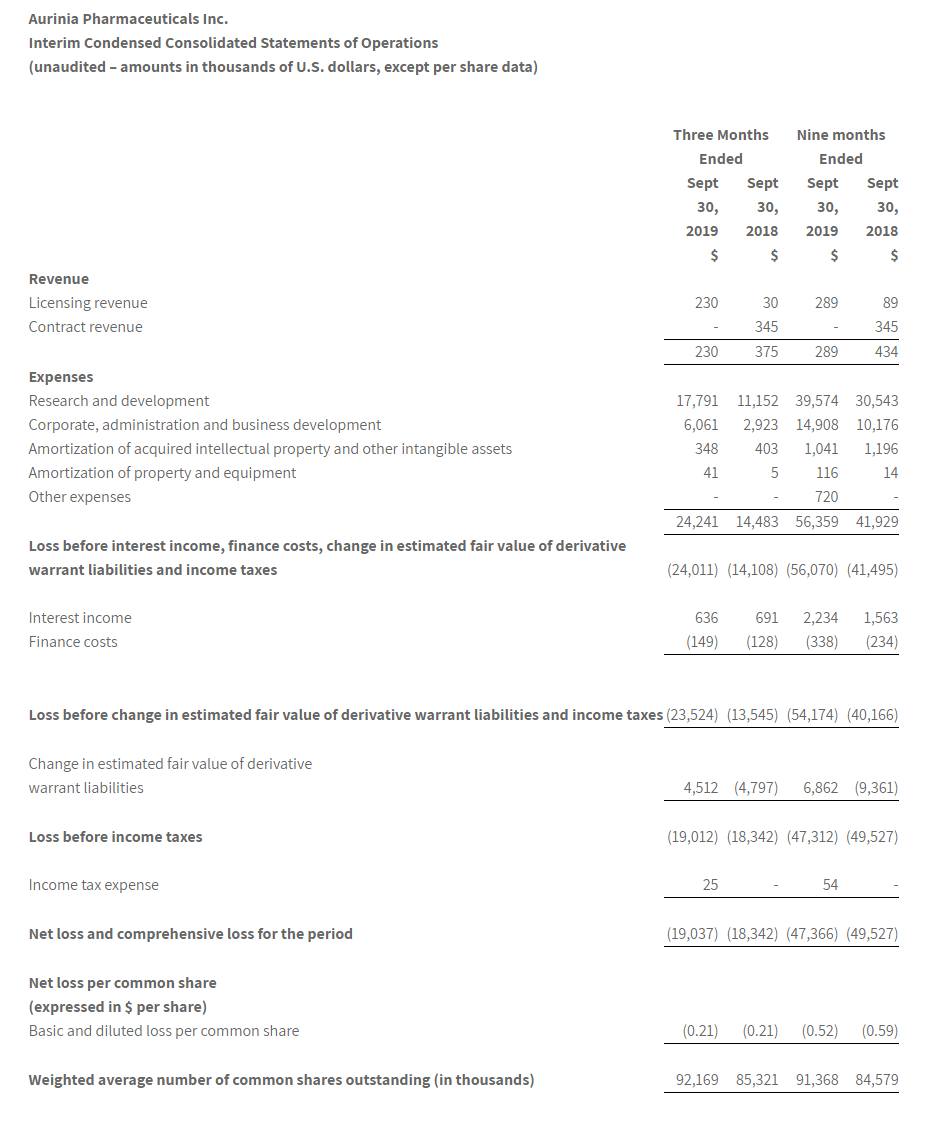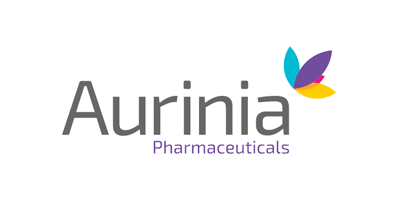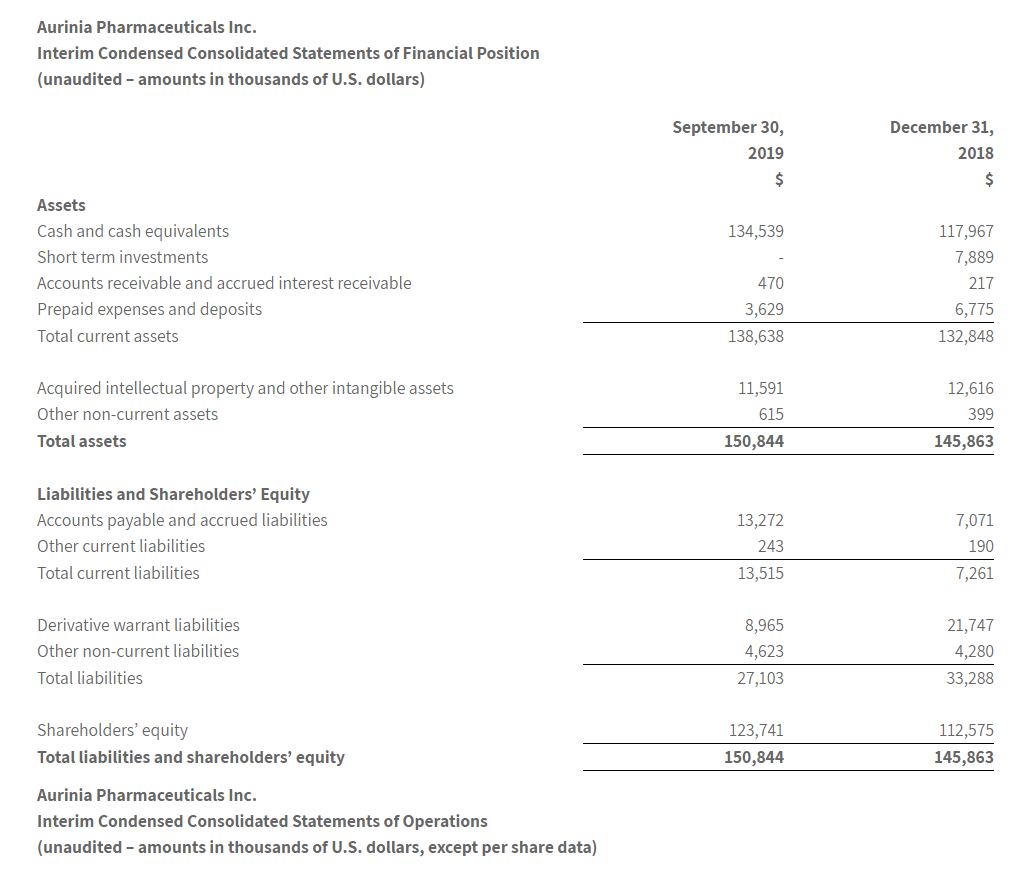VICTORIA, British Columbia — (BUSINESS WIRE) — Aurinia Pharmaceuticals Inc. (NASDAQ: AUPH / TSX:AUP) (“Aurinia” or the “Company”), a late-stage clinical biopharmaceutical company focused on advancing voclosporin in multiple indications, today reported financial results for the three and nine months ended September 30, 2019 and recent operational highlights. Amounts, unless specified otherwise, are expressed in U.S. dollars.
“As we look forward to results from the AURORA Phase 3 trial for LN by the end of this year, the organization has been preparing for success by continuing to strengthen the Board, making several key strategic hires into our commercial and medical affair groups, and advancing the portfolio of potential indications for voclosporin, including FSGS and dry eye syndrome. Looking ahead to 2020, and assuming positive results, we plan on submitting a NDA to the FDA in the first half of 2020 and project a commercial launch of voclosporin in early 2021 as a potentially first-line treatment, in combination with mycophenolate mofetil, for lupus nephritis.”
– Peter Greenleaf, President and Chief Executive Officer, Aurinia Pharmaceuticals
Voclosporin for Lupus Nephritis (“LN”)
On October 16, Aurinia announced that the last patient study visit had occurred in the AURORA Phase 3 LN trial with efficacy and safety results anticipated by the end of 2019.
The AURORA clinical trial is a global, double-blind, placebo-controlled study to evaluate whether voclosporin, when used in combination with mycophenolate mofetil (“MMF”)/CellCept®, can increase complete renal response rates at 52 weeks in the presence of low dose steroids. A total of 358 patients with LN were randomized into sites across 27 countries.
AURORA 2 is an extension study whereby eligible patients from AURORA have the option of continuing their therapy for an additional two years in a blinded fashion. Results of this study are not required for FDA approval; however, AURORA 2 is expected to provide valuable insights as to the long-term safety and efficacy of voclosporin as a potential new treatment for LN.
Voclosporin Ophthalmic Solution (“VOS”) Phase 2/3 AUDREY™ Clinical Trial in Dry Eye Syndrome (“DES”)
On October 31, Aurinia announced the initiation of patient dosing in the Phase 2/3 AUDREY™ clinical trial evaluating VOS for the potential treatment of DES. The AUDREY trial is a randomized, double-masked, vehicle-controlled, dose-ranging study evaluating the efficacy and safety of VOS in subjects with DES. A total of approximately 480 subjects are expected to be enrolled. The study will consist of four arms with a 1:1:1:1 randomization schedule, in which patients will receive either 0.2% VOS, 0.1% VOS, 0.05% VOS or vehicle, dosed twice daily for 12 weeks.
The primary outcome measure for the trial is the proportion of subjects with a 10mm improvement in Schirmer Tear Test (“STT”) at four weeks. Secondary outcome measures will include STT at other time points, Fluorescein Corneal Staining (“FCS”) at multiple time points, change in eye dryness, burning/stinging, itching, photophobia, eye pain and foreign body sensation at multiple time points, and additional safety endpoints.
Top-line results from AUDREY are anticipated during the second half of 2020.
Financial Liquidity at September 30, 2019
As of September 30, 2019, Aurinia had cash and cash equivalents of $134.5 million compared to $131.5 million at June 30, 2019 and $118.0 million at December 31, 2018.
The Company received net proceeds of $14.3 million upon the sale of 2.35 million common shares at a weighted average price of $6.40 per share pursuant to its September 13, 2019 At-the-market (“ATM”) facility with Jefferies LLC.
Net cash used in operating activities was $11.8 million and $38.2 million respectively for the three and nine months ended September 30, 2019 compared to $11.3 million and $38.0 million respectively for the same periods in 2018.
The Company believes, that based on its current plans, it has sufficient financial resources to fund the existing LN program, including the AURORA trial and the AURORA 2 extension study, complete the New Drug Application (“NDA”) submission to the FDA, conduct the ongoing Phase 2 study for focal segmental glomerulosclerosis (“FSGS”), conduct the AUDREY clinical trial, and fund operations into the fourth quarter of 2020.

Third Quarter 2019 Financial Results
For the three months ended September 30, 2019 Aurinia reported a consolidated net loss of $19.0 million or $0.21 per common share compared to a consolidated net loss of $18.3 million or $0.21 per common share for the same period in 2018.
Research and development expenses (R&D) increased to $17.8 million for the three months ended September 30, 2019, compared to $11.2 million for the three months ended September 30, 2018. The increase in these expenses were primarily related to the manufacturing of voclosporin for commercial and investigational use. In addition, higher costs were incurred for the AURORA 2 extension study, completion of the drug-drug interaction (“DDI”) study, preparation costs associated with the planned NDA submission for LN, and initiation of the Phase 2/3 DES clinical trial, partially offset by lower AURORA clinical trial costs.
Corporate, administration and business development expenses increased to $6.1 million for the three months ended September 30, 2019, compared to $2.9 million for the same period in 2018. The increase reflected overall higher activity levels as the Company scales the organization ahead of AURORA Phase 3 results in LN. The Company incurred higher costs for professional and consulting services, insurance, personnel and information technology and for pre-commercial activities, including market research.
Non-cash stock compensation expense was $2.0 million for the third quarter ended September 30, 2019 as compared with $1.5 million for the same period in 2018 and was included in both R&D and corporate, general and business development expenses.
Aurinia also recorded a non-cash reduction of $4.5 million in the estimated fair value of derivative warrant liabilities which reduced the loss for the third quarter ended September 30, 2019 compared to an increase of $4.8 million in the estimated fair value of derivative warrant liabilities which increased the loss for the third quarter ended September 30, 2018. The derivative warrant liabilities will ultimately be eliminated on the exercise or forfeiture of the warrants and will not result in any cash outlay by the Company.
Financial Results for Nine Months Ended September 30, 2019
For the nine months ended September 30, 2019, Aurinia reported a consolidated net loss of $47.4 million or $0.52 per common share compared to a consolidated net loss of $49.5 million or $0.59 per common share for the comparable period in 2018.
R&D expenses were $39.6 million for the nine months ended September 30, 2019 compared to $30.5 million for the same period in 2018. The increase in these expenses were primarily related to the manufacturing of voclosporin for commercial and investigational use. In addition, higher costs were incurred for the AURORA 2 extension study, completion of the drug-drug interaction study, preparation costs associated with the planned NDA submission for LN, and initiation of the Phase 2/3 DES clinical trial, partially offset by lower AURORA clinical trial costs.
Corporate, administration and business development expenses were $14.9 million for the nine months ended September 30, 2019 compared to $10.2 million for the same period in 2018. The increase reflected overall higher activity levels as the Company scales the organization ahead of AURORA Phase 3 results in LN. The Company incurred higher costs for professional and consulting services, insurance, personnel and information technology and for pre-commercial activities, including market research.
Non-cash stock compensation expense was consistent at $5.6 million for both the nine months ended September 30, 2019 and the nine months ended September 30, 2018 and was included in both R&D and corporate, general and business development expenses.
For the nine months ended September 30, 2019 Aurinia recorded a decrease of $6.9 million in the estimated fair value of derivative warrant liabilities compared to an increase of $9.4 million for the comparable period in 2018.
This press release should be read in conjunction with our unaudited interim condensed consolidated financial statements and the Management’s Discussion and Analysis for the third quarter ended September 30, 2019 which are accessible on Aurinia’s website at www.auriniapharma.com, on SEDAR at www.sedar.com or on EDGAR at www.sec.gov/edgar.
Aurinia will host a conference call and webcast to discuss the third quarter ended September 30, 2019 financial results today, Thursday , November 14, 2019 at 4:30 p.m. ET. This event can be accessed on the investor section of the Aurinia website.
Related Article: Aurinia Releases Q2 2019 Financial Results
About Aurinia
Aurinia Pharmaceuticals is a late clinical-stage biopharmaceutical company focused on developing and commercializing therapies to treat targeted patient populations that are impacted by serious diseases with a high unmet medical need. The Company is currently developing an investigational drug, for the treatment of Lupus Nephritis, Focal Segmental Glomerulosclerosis and Dry Eye Syndrome. The Company’s head office is in Victoria, British Columbia and focuses its development efforts globally.
About Voclosporin
Voclosporin, an investigational drug, is a novel and potentially best-in-class calcineurin inhibitor (“CNI”) with clinical data in over 2,600 patients across indications. Voclosporin is an immunosuppressant, with a synergistic and dual mechanism of action. By inhibiting calcineurin, voclosporin blocks IL-2 expression and T-cell mediated immune responses and stabilizes the podocyte in the kidney. It has been shown to have a more predictable pharmacokinetic and pharmacodynamic relationship (potentially requires no therapeutic drug monitoring), an increase in potency (vs cyclosporin), and an improved metabolic profile compared to legacy CNIs. Aurinia anticipates that upon regulatory approval, patent protection for voclosporin will be extended in the United States and certain other major markets, including Europe and Japan, until at least October 2027 under the Hatch-Waxman Act and comparable laws in other countries and until April 2028 with anticipated pediatric extension. Further, the new Notice of Allowanceis expected to result in the issuance of a U.S. patent with a term extending to December 2037. If the FDA approves the use of voclosporin for LN and the label for such use follows the dosing protocol under the Notice of Allowance, the issuance of this patent will expand the scope of intellectual property protection for voclosporin to December 2037.
About VOS
Voclosporin ophthalmic solution (“VOS”) is an aqueous, preservative free nanomicellar solution intended for use in the treatment of DES. A Phase 2a study was recently completed with results released in January of 2019. Previously, a Phase 1 study with healthy volunteers and patients with DES was also completed as were studies in rabbit and dog models. VOS has IP protection until 2031.
About LN
Lupus Nephritis (“LN”) in an inflammation of the kidney caused by Systemic Lupus Erythematosus (“SLE”) and represents a serious progression of SLE. SLE is a chronic, complex and often disabling disorder. The disease is highly heterogeneous, affecting a wide range of organs and tissue systems. Unlike SLE, LN has straightforward disease outcomes (measuring proteinuria) where an early response correlates with long-term outcomes. In patients with LN, renal damage results in proteinuria and/or hematuria and a decrease in renal function as evidenced by reduced estimated glomerular filtration rate (“eGFR”), and increased serum creatinine levels. LN is debilitating and costly and if poorly controlled, LN can lead to permanent and irreversible tissue damage within the kidney, resulting in end-stage renal disease (“ESRD”), thus making LN a serious and potentially life-threatening condition.
About FSGS
Focal segmental glomerulosclerosis (“FSGS”) is a rare disease that attacks the kidney’s filtering units (glomeruli) causing serious scarring which leads to permanent kidney damage and even renal failure. FSGS is one of the leading causes of Nephrotic Syndrome (“NS”) and is identified by biopsy and proteinuria. NS is a collection of signs and symptoms that indicate kidney damage, including large amounts of protein in the urine; low levels of albumin and higher than normal fat and cholesterol levels in the blood, and edema. Similar to LN, early clinical response (measured by reduction of proteinuria) is thought to be critical to long-term kidney health in patients with FSGS. Currently, there are no approved therapies for FSGS in the United States and the European Union.
About DES
Dry eye syndrome (“DES”) is characterized by irritation and inflammation that occurs when the eye’s tear film is compromised by reduced tear production, imbalanced tear composition, or excessive tear evaporation. The impact of DES ranges from subtle, yet constant eye irritation to significant inflammation and scarring of the eye’s surface. Discomfort and pain resulting from DES can reduce quality of life and cause difficulty reading, driving, using computers and performing daily activities. DES is a chronic disease. There are currently three FDA approved therapies for the treatment of dry eye; however, there is opportunity for potential improvement in the effectiveness by enhancing tolerability, onset of action and alleviating the need for repetitive dosing.
Forward-Looking Statements
Certain statements made in this press release may constitute forward-looking information within the meaning of applicable Canadian securities law and forward-looking statements within the meaning of applicable United States securities law. These forward-looking statements or information include but are not limited to statements or information with respect to: AURORA Phase 3 LN trial efficacy and safety results anticipated by the end of 2019, completing NDA submission in a successful and timely manner including the anticipated NDA filing during the first half of next year and subsequent commercial launch in 2021, voclosporin being potentially a best-in-class CNI with robust intellectual property exclusivity; results from the AUDREY trial in DES during the second half of 2020; the expected timing of FSGS results and patient enrollment; and that Aurinia has sufficient financial resources to fund the existing LN program, including the AURORA trial and the AURORA 2 extension study, complete the NDA submission to the FDA, conduct the ongoing Phase 2 study for FSGS, conduct the AUDREY clinical trial, and fund operations into the fourth quarter of 2020. Aurinia’s anticipation that upon regulatory approval, patent protection for voclosporin will be extended in the United States and certain other major markets, including Europe and Japan, until at least October 2027 under the Hatch-Waxman Act and comparable laws in other countries and until April 2028 with anticipated pediatric extension; that the new Notice of Allowance is expected to result in the issuance of a U.S. patent with a term extending to December 2037; that if the FDA approves the use of voclosporin for LN and the label for such use follows the dosing protocol under the Notice of Allowance, the issuance of this patent will expand the scope of intellectual property protection for voclosporin to December 2037. It is possible that such results or conclusions may change based on further analyses of these data. Words such as “anticipate”, “will”, “believe”, “estimate”, “expect”, “intend”, “target”, “plan”, “goals”, “objectives”, “may” and other similar words and expressions, identify forward-looking statements. We have made numerous assumptions about the forward-looking statements and information contained herein, including among other things, assumptions about: the market value for the LN, DES and FSGS programs; that another company will not create a substantial competitive product for Aurinia’s LN, DES and FSGS business without violating Aurinia’s intellectual property rights; the burn rate of Aurinia’s cash for operations; the costs and expenses associated with Aurinia’s clinical trials; the planned studies achieving positive results; Aurinia being able to extend and protect its patents on terms acceptable to Aurinia; and the size of the LN, DES or FSGS markets. Even though the management of Aurinia believes that the assumptions made, and the expectations represented by such statements or information are reasonable, there can be no assurance that the forward-looking information will prove to be accurate.
Forward-looking information by their nature are based on assumptions and involve known and unknown risks, uncertainties and other factors which may cause the actual results, performance or achievements of Aurinia to be materially different from any future results, performance or achievements expressed or implied by such forward-looking information. Should one or more of these risks and uncertainties materialize, or should underlying assumptions prove incorrect, actual results may vary materially from those described in forward-looking statements or information. Such risks, uncertainties and other factors include, among others, the following: difficulties, delays, or failures we may experience in the conduct of our clinical trial; difficulties we may experience in completing the development and commercialization of voclosporin; the market for the LN, DES and FSGS business may not be as estimated; Aurinia may have to pay unanticipated expenses; estimated costs for clinical trials may be underestimated, resulting in Aurinia having to make additional expenditures to achieve its current goals; Aurinia not being able to extend or fully protect its patent portfolio for voclosporin; and competitors may arise with similar products. Although we have attempted to identify factors that would cause actual actions, events or results to differ materially from those described in forward-looking statements and information, there may be other factors that cause actual results, performances, achievements or events to not be as anticipated, estimated or intended. Also, many of the factors are beyond our control. There can be no assurance that forward-looking statements or information will prove to be accurate, as actual results and future events could differ materially from those anticipated in such statements. Accordingly, you should not place undue reliance on forward-looking statements or information.
Except as required by law, Aurinia will not update forward-looking information. All forward-looking information contained in this press release is qualified by this cautionary statement. Additional information related to Aurinia, including a detailed list of the risks and uncertainties affecting Aurinia and its business can be found in Aurinia’s most recent Annual Information Form available by accessing the Canadian Securities Administrators’ System for Electronic Document Analysis and Retrieval (SEDAR) website at www.sedar.com or the U.S. Securities and Exchange Commission’s Electronic Document Gathering and Retrieval System (EDGAR) website at www.sec.gov/edgar.

